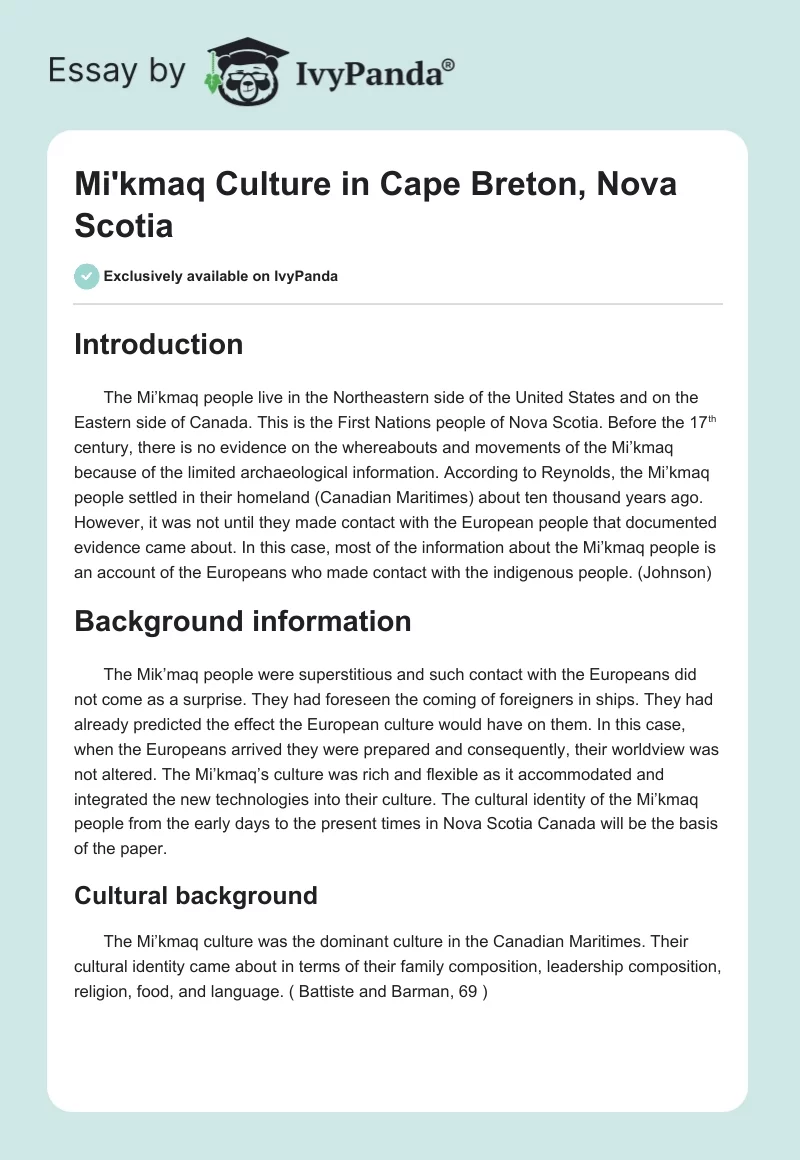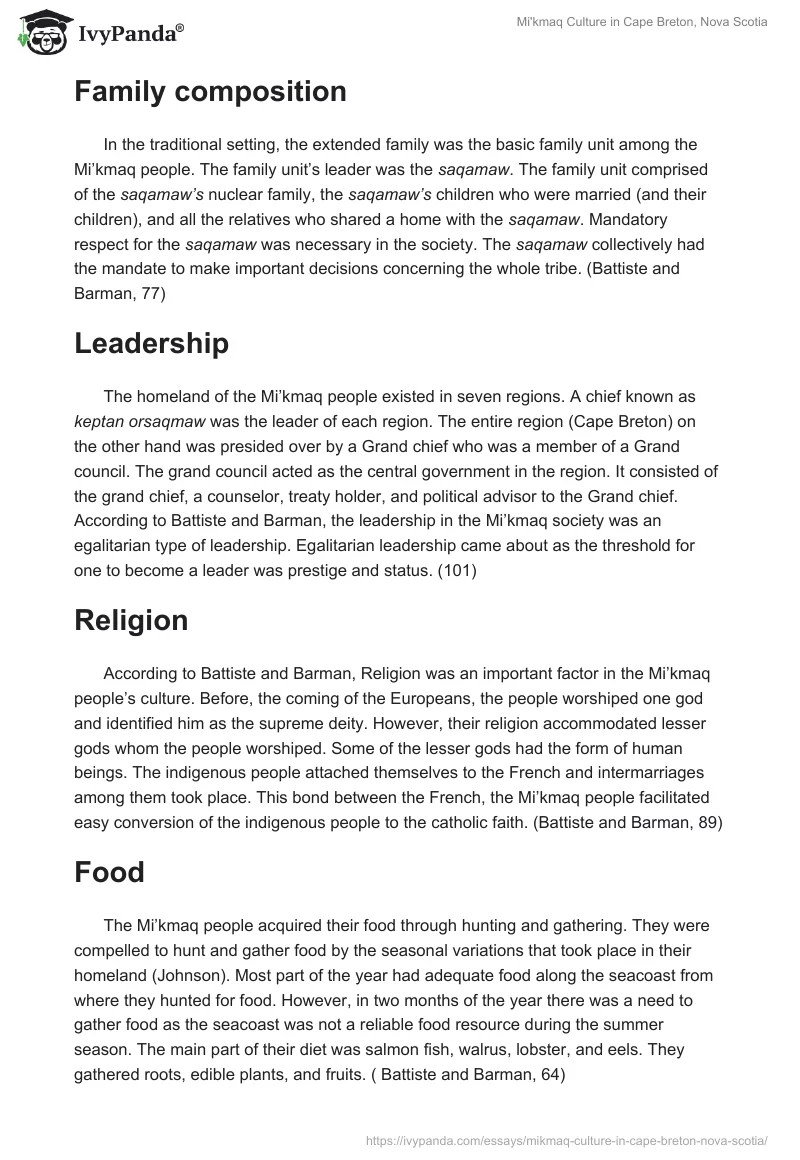Introduction
The Mi’kmaq people live in the Northeastern side of the United States and on the Eastern side of Canada. This is the First Nations people of Nova Scotia. Before the 17th century, there is no evidence on the whereabouts and movements of the Mi’kmaq because of the limited archaeological information. According to Reynolds, the Mi’kmaq people settled in their homeland (Canadian Maritimes) about ten thousand years ago. However, it was not until they made contact with the European people that documented evidence came about. In this case, most of the information about the Mi’kmaq people is an account of the Europeans who made contact with the indigenous people. (Johnson)
Background information
The Mik’maq people were superstitious and such contact with the Europeans did not come as a surprise. They had foreseen the coming of foreigners in ships. They had already predicted the effect the European culture would have on them. In this case, when the Europeans arrived they were prepared and consequently, their worldview was not altered. The Mi’kmaq’s culture was rich and flexible as it accommodated and integrated the new technologies into their culture. The cultural identity of the Mi’kmaq people from the early days to the present times in Nova Scotia Canada will be the basis of the paper.
Cultural background
The Mi’kmaq culture was the dominant culture in the Canadian Maritimes. Their cultural identity came about in terms of their family composition, leadership composition, religion, food, and language. ( Battiste and Barman, 69 )
Family composition
In the traditional setting, the extended family was the basic family unit among the Mi’kmaq people. The family unit’s leader was the saqamaw. The family unit comprised of the saqamaw’s nuclear family, the saqamaw’s children who were married (and their children), and all the relatives who shared a home with the saqamaw. Mandatory respect for the saqamaw was necessary in the society. The saqamaw collectively had the mandate to make important decisions concerning the whole tribe. (Battiste and Barman, 77)
Leadership
The homeland of the Mi’kmaq people existed in seven regions. A chief known as keptan orsaqmaw was the leader of each region. The entire region (Cape Breton) on the other hand was presided over by a Grand chief who was a member of a Grand council. The grand council acted as the central government in the region. It consisted of the grand chief, a counselor, treaty holder, and political advisor to the Grand chief. According to Battiste and Barman, the leadership in the Mi’kmaq society was an egalitarian type of leadership. Egalitarian leadership came about as the threshold for one to become a leader was prestige and status. (101)
Religion
According to Battiste and Barman, Religion was an important factor in the Mi’kmaq people’s culture. Before, the coming of the Europeans, the people worshiped one god and identified him as the supreme deity. However, their religion accommodated lesser gods whom the people worshiped. Some of the lesser gods had the form of human beings. The indigenous people attached themselves to the French and intermarriages among them took place. This bond between the French, the Mi’kmaq people facilitated easy conversion of the indigenous people to the catholic faith. (Battiste and Barman, 89)
Food
The Mi’kmaq people acquired their food through hunting and gathering. They were compelled to hunt and gather food by the seasonal variations that took place in their homeland (Johnson). Most part of the year had adequate food along the seacoast from where they hunted for food. However, in two months of the year there was a need to gather food as the seacoast was not a reliable food resource during the summer season. The main part of their diet was salmon fish, walrus, lobster, and eels. They gathered roots, edible plants, and fruits. ( Battiste and Barman, 64)
Language
The language spoken by the Mi’kmaq people was one of the rich and descriptive heritages known as the Aglonkian family heritage. According to Battiste and Barman, this language had similarities with that spoken by their neighbors the Malecite and the Innu(95). Presently some of the Mi’kmaq people practice using the Aglonkian language and use it as their first language. English and French is the secondary language to such people. (Johnson)
Current situation of the Mi’qmak people’s cultural identity
According to Poliandri, Mi’kmaq’s cultural identity definition as well as reinforcement comes about by placing other communities in certain positions within their social landscape for purposes of comparison, association or both (54). In this case, we will focus on the particular changes that the community has made in relation to preserving its cultural identity since the 17th century. This will promote understanding the Mi’kmaq people’s identity variation and present the unique nature of this indigenous people.
According to Poliandri, the Mi’kmaq, language has presently taken a revolutionary turn since the 17th century (24). In the Mi’kmaq nation, it has revolutionized to a polysynthetic language spoken by over eight hundred speakers. Recent events have shown evidence of a developed interest in the verb oriented language. According to Reynolds, one of them is the integration of the language in the reservation schools curriculums. In the 1970’s an orthography that has been in use up to date has facilitated the Integration. The orthography developed the language’s sounds providing an accurate presentation in the language sound (Johnson).
In addition, to the preservation of language, maintaining some social elements is essential for purposes of maintaining their cultural identity. An example is a game known as Walters. The Europeans and Americans were of the opinion that the game was a heathen gambling game played for purposes of promoting gambling and promiscuity (Johnson).The game however, has survived such critics and the Indian clergy that was eager to eradicate it for a long time. The Mi’kmaq society has also decided not to sideline their traditional skills in basket making and hide furbishing (Johnson)
In conclusion, despite the Mi’kmaq society in Nova Scotia losing most of its cultural elements, it has been able to retain most of the fundamental qualities. In a population of about twenty thousand, the Mi’kmaq people have achieved a one-third ratio of educated people in that society. Education has become an integral part of their livelihood since the integration of their language the in the reserves curriculum. The academic curriculum has facilitated in enriching the tribes culture by enriching the Mi’kmaq’s history. For the Mi’kmaq to ensure their tribe survives possible extinction it is important they recognize the importance of the tribe’s culture and traditions in promoting the tribes continuity. (Johnson)
Works Cited
Battiste, Marie and Jean Barman. First Nations Education in Canada: The Circle Unfolds. Sydney: Cape Breton University, 1995. Print.
Johnson, Eleanor. The Mi’kmaq. n.d. Web.
Poliandri, Simone. First Nations, Identity, and Reserve Life, First Nations, Identity, and Reserve Life. Sydney: Cape Breton University, 2011. CBU NetLibrary. Web.
Reynolds, Jonathan. Teaching First Nations History as Canadian History. 2008. Web.

